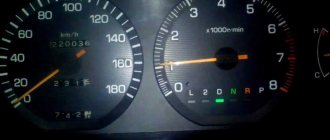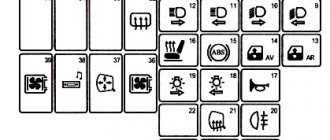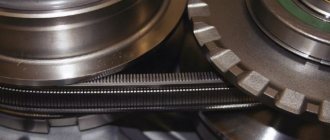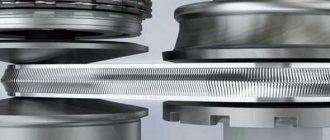Lada Largus automatic transmission is an unavailable option for the Russian station wagon, which all owners and potential buyers of this model dream of. Unfortunately, at the moment, none of the Lada Largus configurations are equipped with an automatic transmission.
But don’t rush to get upset and close the page. At the end of the article there will be very interesting and entertaining information. Now let's continue.
New Lada Largus automatic 2022 - will there be an automatic transmission?
Not long ago, photos from road tests of the Lada Largus 2021 FL appeared on the Internet. And we thought a little about the possibility of a new engine with an automatic transmission appearing under the hood. The fact is that the lenses of spy photographers caught the new Lada Largus FL from Kabardino-Balkaria.
The most interesting thing is that Lagrus was tested with a trailer, and this suggests that they were testing a new engine or gearbox, or maybe both. Otherwise, why test with additional load?
The most likely thing is that the new product will be equipped with a 1.8-liter naturally aspirated unit, which is well known to us from the LADA XRAY. However, installing a 1.8 liter engine under the hood of the Lada Largus will lead to a revision of the existing gearboxes. And here they can install either a robotic gearbox or a classic Jatco automatic. And as we know, AvtoVAZ perfectly knows how to “make friends” 1.8 with these transmissions.
There is another option - the appearance of a variator under the hood of the Largus FL, which may also require the installation of a new engine. And the most likely option would be the 1.6 H4M with 113 hp.
In any case, the appearance of the Lada Largus 2022 assault rifle is quite likely and not such a utopian possibility.
Lada Largus Station wagon 5 seats
5 advantages and one big disadvantage of the Lada Largus
This variation of the car is truly family-friendly. This choice allows us to fully ensure the safety of people. The car is equipped with side and front airbags and an ABS system. The model is also reinforced with additional steel profiles. Both the driver and passengers can feel calm and confident inside the car. Lada Largus is able to maintain a smooth ride and excellent maneuverability even on uneven roads with potholes and holes.
The Lada Largus 5-seater configuration includes a 1.6-liter engine (8/16 valves, producing 82/104 hp), which makes you feel comfortable behind the wheel. The power of this model meets all modern requirements.
In addition to its pleasant appearance, power and maneuverability, such a station wagon is also economical. Fuel consumption in the combined cycle is only 7.5-8 liters per 100 km.
It is worth mentioning the interior design of the 5-seater model. It is roomy enough for a family with even the most restless little ones. Ergonomic seats will be appreciated by even the most demanding and capricious passengers. Drivers will certainly enjoy the comfortable steering wheel and well-designed instrument panel. All elements of the interior are designed in the same style and the result is an overall harmonious design.
Of course, a large family most often transports a lot of things, especially when traveling on vacation. Having purchased a Lada Largus, there will be no problem with trunk capacity. The five-seater version has a trunk volume of 560 liters. This is even more than enough to transport almost any luggage.
It is also worth noting that the five-seater station wagon of the “Norma” variation has tinted windows, power steering, a driver’s airbag, power windows, interior and trunk lamps. The child seat fastening system will please parents and ensure the safety of the child on the road.
The Luxury package is somewhat wider and also includes a front passenger airbag, fog lights, electrically heated and electrically adjustable exterior mirrors, heated seats, and air conditioning.
Prices for a five-seater Lada Largus, depending on its class and configuration, range from 496,000 to 593,200 rubles.
The five-seater Lada Largus has a length of 4470 m, a width of 1750 m and a height of 1636 m. The body type is station wagon. The car is front-wheel drive with a front transverse engine. The engine is four-stroke with a displacement of 1598 cc. Type of fuel: unleaded gasoline AI-95. Transmission: five-speed manual. The maximum speed that such a car can reach is 165 km/h. Number of doors – 6. The power system involves distributed injection with electronic control. Fuel consumption in the combined cycle is an average of 9.0 liters.
Self-installation of the machine on Lada Largus
At the moment, nothing is impossible at all and installing a Lada Largus automatic machine is not such a difficult task. If you have free time and money, you can do anything.
The older brother of LADA Largus is Renault LOGAN, which was produced with an automatic transmission. Logan was equipped with an automatic transmission with the index DP0. This box can be installed without major modifications on a Largus station wagon with engines manufactured by Renault. But there is a significant problem - it is very difficult to find such a box for disassembly, since Logans with an automatic rifle are very rare.
What else is required to install an automatic transmission on a Lada Largus?
- Wiring from a car with automatic transmission
- Engine ECU
- Gear knob
- Interior plastic
- Transmission cushions
- Drive assembly with CV joint
- Hubs
- Flywheel
- Transmission cables
How much would such a modification cost? It all depends on the availability of contract spare parts in your city and the price tags for them. According to the most conservative estimates - from 50 thousand rubles and above. And this takes into account the fact that all work will be done independently. The problem is not in the mechanical part, but in merging the electrical parts and installing a new ECU. But, as they say, if you want, you can move mountains.
Story
The original station wagon based on the first Logan went into mass production in 2006, and a couple of years later the car was restyled. A descendant under the Lada brand, namely the Largus model, was presented in 2011. Largus entered mass production in 2012. The following year, the second generation Logan MCV appeared. At the same time, Largus has not yet undergone large-scale restyling, which, however, has little effect on its popularity. In 2015, Largus received a Cross modification, which the prototype does not have.
Lada Largus automatic transmission price
To find the price of a contract automatic transmission for a Lada Largus, we will use the drom.ru message board. We go to the parts, put the brand and model of Renault Logan, 1st generation and select the automatic transmission assembly.
As we see, almost all options are made to order from Europe. In Russia, there are practically no first Logans with automatic transmission available for analysis. The price for a contract automatic transmission starts from 35 thousand rubles and up to 45 thousand.
Body
Lada Largus is available in two body styles: station wagon and van. It should be noted that the first Logan had a station wagon (MCV) body, and the van was produced under the name Logan Van.
In comparison with the Logan sedan, this model received an increase in height and wheelbase by 100 and 270 mm, respectively. The length of the car is 4.45 m, width – 1.74 m, height – 1.64 m. The wheelbase is 2.9 m, the track is 1.48 m in the front and 1.47 m in the rear. That is, the car is very large for segment B.
Due to the fact that the original car was initially well adapted to local conditions, its design underwent minimal changes during adaptation. Thus, the treatment area with anti-gravel and anti-noise mastic was expanded, linings were installed on the arches and air ducts for the passenger rows of seats, and the washer fluid tank was increased to 5 liters.
The Cross modification is presented in passenger versions. Externally, it is distinguished by bumpers, arch trims and sills made of unpainted plastic, as well as black pillars.
Lada Largus manual or automatic?
At the moment, Lada Largus is produced only with a manual transmission. We are talking about all modifications (station wagon, van). As well as Cross versions for 5 and 7 seats. It is impossible to buy a Lada Largus automatic from dealers.
But which is better? Undoubtedly, both automatic and manual transmissions have their advantages and disadvantages. The manual transmission is distinguished by its reliability and unpretentiousness. Servicing a manual transmission is cheaper and easier. However, an automatic is more comfortable to drive, but it cannot be towed or carried heavy loads. In the event of a breakdown, repairing an automatic transmission will be significantly more expensive. And a scheduled oil change will be many times more expensive than a manual one.
Reviews
Owners evaluate the car differently. They like, first of all, the cargo-passenger parameters - the spaciousness of the cabin and trunk. They also note the high seating position, which provides good visibility, and the soft suspension, characteristic of cars built on this platform. Many are satisfied with the engine power. They also note that the machine is highly economical and reliable.
An uncomfortable interior is mentioned as disadvantages, namely the low quality of materials used in assembly, poor sound insulation and ergonomics, a small selection of options, among which there are not even the simplest of them. Many people find the gearbox inconvenient due to short gears, which leads to noise and increased fuel consumption. Also, many people lack all-wheel drive for the Lada-Largus automatic and a more powerful engine.
As for repairs, most owners were faced with only planned work. There are no typical weak points noted, with the exception of ball joints and headlight bulbs.
How to pour oil into a jack - step by step diagram
Step 1: Flushing the mechanism
In order to fill the jack with oil, you must first unscrew the plug and drain the old fluid. The next step is to clean the mechanism using washing liquid, which can be purchased at any hardware store. By the way, it is quite difficult to completely wash the jack, especially for a beginner, because you will have to fill in the liquid at least two or three times, after which it is pumped, the liquid is added again and pumped again. Draining the old oil is done in the same way - so that not a drop of old fluid remains inside the mechanism.
Step 2: Adding Oil
The container must be filled with oil completely, that is, until the liquid reaches the required level. At the same time, install the jack in a low position. To lower the rod to the lower position, be sure to turn the valve screw until it reaches the “drain” position. After tightening the plug, we pump it five times, after which we add oil and tighten the plug again. During the cleaning process there will not be enough oil every time, and therefore it is necessary to pump until the “fuel” of our jack reaches the required level and bubbles stop appearing on the surface of the liquid.
Characteristics
| Wheel formula / drive wheels |
| Engine location |
| Body type / number of doors |
| Length / width / height, mm |
| Base, mm |
| Front/rear wheel track, mm |
| Ground clearance, mm |
| Luggage compartment volume in passenger/cargo… |
| engine's type |
| Supply system |
| Number, arrangement of cylinders |
| Working volume, cubic meters cm |
| Maximum power, hp / kW / rev. min. |
| Maximum torque, Nm / rev. min. |
| Fuel |
| Maximum speed, km/h |
| Acceleration time 0-100 km/h, s |
| Urban cycle, l/100 km |
| Extra-urban cycle, l/100 km |
| Combined cycle, l/100 km |
| Curb weight, kg |
| Total weight, kg |
| Fuel tank volume, l |
| Permissible gross weight of a towed trailer with... |
| Permissible gross weight of the towed trailer without... |
| Transmission type |
| Main gear ratio |
| Front |
| Rear |
| Steering gear |
| Dimension |
What changed
Exterior and interior
The hood line has become higher. The changed aerodynamics reduced lift by 13% for the van and station wagon and by 16% for the Cross version. Largus, of course, is not a sports car, but improved performance at speed should be welcomed in any car.
The front bumper has stampings for four parking sensors - another preparation for future micro-modernization. The lower overlay is not painted in bulk, but in a classic way. Scratches on it will shine with black scars.
The front bumper has stampings for four parking sensors - another preparation for future micro-modernization. The lower overlay is not painted in bulk, but in a classic way. Scratches on it will shine with black scars.
The chrome “sabers” of the front bumper are confusing: on the editorial Vesta they began to lose their presentation after the third winter. Now, in my sixth year, I try not to look at a clean car again: it’s no longer “chrome”, but its appearance. On the pre-restyling Largus from our fleet, the shiny radiator grille insert quickly and willingly peeled off. VAZ employees assure that now everything is in order with chrome. Oh well.
The instrument cluster was shared by XRAY Cross. The display on the right is still single-line, and you have to choose one from the abundance of options.
The instrument cluster was shared by XRAY Cross. The display on the right is still single-line, and you have to choose one from the abundance of options.
The seat heating buttons are in normal places. The windshield, steering wheel and rear seats get warm.
The seat heating buttons are in normal places. The windshield, steering wheel and rear seats get warm.
The front panel from Duster was carried over with minimal changes. Better than it was, but if you expand the coordinate system, it’s still not modern. The central display is located very low. The media system includes Android Auto and Apple CarPlay. Light and rain sensors appeared. But the brushes are still short. With a height of 186 cm and the seat lowered to the limit, I look at the upper limit of the cleaning zone. For a good view, you will have to slouch or tilt your back.
The front panel from Duster was carried over with minimal changes. Better than it was, but if you expand the coordinate system, it’s still not modern. The central display is located very low. The media system includes Android Auto and Apple CarPlay. Light and rain sensors appeared. But the brushes are still short. With a height of 186 cm and the seat lowered to the limit, I look at the upper limit of the cleaning zone. For a good view, you will have to slouch or tilt your back.
Headlights
Gearbox malfunctions and methods for eliminating them
Any mechanism has a tensile strength, especially if it operates under variable loads. It is necessary to take into account the driver's driving style, which significantly affects the durability of the part. Summarizing the accumulated experience and analysis of breakdowns that occur during the operation of the car, gearbox faults can be grouped into several main groups: noise in the gearbox, difficulty engaging the gear and spontaneous shutdown of the transmission.
Noise and difficulty shifting gears
The main causes of noise in the gearbox include:
- low oil level;
- water entering the system;
- wear of bearings or gears.
To fix the problem, you should add or replace the oil in the gearbox, replace the bearings and gears with new ones.
Difficulty shifting gears can be caused by the following factors:
- faulty gearbox control rod;
- loosening of fastenings;
- deformation of control drive parts;
- wear of synchronization rings;
- incomplete disengagement of the clutch.
The listed faults can easily be eliminated by adjusting the clutch and replacing deformed and worn parts. It also helps to adjust the mechanisms in accordance with the regulations indicated in the car’s operating manual.
Spontaneous transmission shutdown
The reasons for spontaneous shutdown of the gearbox are usually:
- gear wear;
- damage occurs on the rubber supports of the box;
- wear of the synchronizer rings.
These faults can only be corrected by replacing them with new parts. Do-it-yourself transmission repair requires high qualifications and a set of special tools. Only a competent specialist can remove and disassemble this part correctly.
If the gearbox malfunctions, it is better to contact a service station, where they will not only repair the unit, but will also give you a guarantee that you can use in the event of a subsequent gearbox breakdown.
Brakes
Brake pads, Drum pads, Pad wear sensor, Pad repair kit, Pad spacer, Rear pads, Handbrake pads, Front pads, Brake linings, Brake discs, Rear brake discs, Front brake discs, Brake drum, Rear brake drum, Drum bearing, Brake hoses, Brake pipes, Brake caliper, Caliper repair kit, Rear caliper, Caliper guides, Front caliper, Caliper piston, Caliper boot, Caliper bracket, Hydraulic accumulator, Vacuum brake booster, ABS, ABS unit, ABS sensor, Vacuum pump, Brake pedal, Switch Brake Light, Air Brakes, Parking Brake, Handbrake Cable, Brake Cylinder, Master Cylinder, Brake Reservoir, Brake Service Cylinder, Rear Brake Cylinder, Front Brake Cylinder, Brake Cylinder Repair Kit
Engine
Initially, Lada Largus was equipped with two imported Renault gasoline four-cylinder engines, including the K7M and K4M.
The K7M is an 8-valve 1.6-liter engine capable of producing up to 86 horsepower at 5,500 rpm and 128 Nm of torque at 3,000 rpm.
K4M is a 16-valve engine of the same displacement. But it is capable of developing up to 102 hp. With. at 5700 rpm and 145 Nm at 3750 rpm.
The first engine was supplied from Romania, the second from Portugal, and since 2013 it began to be assembled under license. A little later, these motors were replaced with their own analogues.
One of them was the VAZ-11189. This is an 8-valve 1.6-liter engine. Develops up to 87 hp. With. power and 140 Nm of torque at 5100 and 3800 rpm, respectively. This engine has been installed since 2015 instead of the K7M.
The second analogue was taken from a VAZ-21129. This is also a 16-valve 1.6-liter engine. Has a power of 106 hp. With. and torque of 148 Nm at 5800 and 4200 rpm, respectively. In 2022 they replaced the K4M.
Unlike Renault analogues, these engines are configured for 92-octane gasoline. It should be noted that Logan MCV and Van, in addition to the above, were equipped with two more engines: a 1.4-liter K7J and a 1.5-liter K9K diesel. However, it was decided not to use them for Largus. The Cross version is equipped only with a 16-valve engine.
The TOP of the most expensive cars to maintain on the Russian market has been compiled - the leaders are known to everyone
In addition, if we analyze the set of power units and available transmissions that are available from representatives of the Renault concern, which is the parent structure of AvtoVAZ, we can conclude that none of them is suitable for the Lada Largus.
At the same time, the management of the Russian company understands that among drivers there is a request specifically for Largus, which would be equipped with an automatic transmission. Therefore, the production of a domestic station wagon with automatic transmission is still possible in the future. It is possible that the developers from AvtoVAZ will take one of the automatic transmissions that are currently equipped with other Lada models.
Author: Konstantin Starchenko
Interior
As noted, Largus has several interior layout options.
Passenger modifications are represented by a 5- and 7-seater station wagon. The first has a trunk volume of 560 liters, the second - 135 liters. In both cases, its volume can be increased to 2,350 liters.
The cargo version has two seats and a luggage compartment with a volume of 2,540 liters. However, it retains the rear side doors, allowing access to the trunk from both sides and the rear.
It was the cargo-passenger capabilities at a low cost that determined the success of the model. You can’t even buy a new 5-seater station wagon for that price, not to mention 7-seater cars. Crossovers are much more expensive, and there are almost no minivans in our market. As for the van, foreign analogues are also much more expensive.











